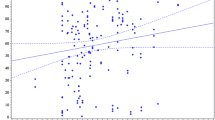Abstract
Growth impairment in infants with unrestrictive ventricular septal defects (VSD) is common, and normalisation of growth has been reported after surgical correction. Literature is inconsistent about growth velocity after surgery in term and preterm infants. We aimed to establish the pattern of catch-up growth in term and preterm infants submitted to VSD surgical correction before 1 year of age. Fifty-two infants (41 term, 11 preterm) were studied. Anthropometric data at birth, surgery and 3, 6, 12 and 24 months after surgery were collected retrospectively. Statistic analyses were performed in SPSS® version 21. At the time of surgery, growth was severely impaired in term and preterm infants. Term infants underwent a period of fast growth within the first 6 months after surgery, achieving posteriorly a normal growth pattern, as both weight and height were not significantly different from the reference population at 24 months after surgery. Preterms caught-up later than term infants but with a significant weight gain within 3 months after surgery.
Conclusion: Early surgical repair of VSD leads to a significant acceleration of growth within 3 to 6 months after surgery, for both groups.
What is Known: |
• Growth impairment in infants with unrestrictive ventricular septal defects is well documented in literature. • Surgical correction in the first months of life is the current option for most ventricular septal defects, leading to a more favourable growth pattern. • Rapid growth during infancy may be associated with the development of insulin resistance, metabolic syndrome, obesity and cardiovascular disease later in life. |
What is New: |
• Literature is inconsistent about catch-up growth velocities after ventricular correction for term infants. • Preterm infants have never been enrolled in previous studies that aimed to establish a pattern of growth after surgery. • This group of children, who underwent a rapid post-surgery catch-up growth that follows a period of failure to thrive, may be at a higher risk of insulin resistance, metabolic syndrome, obesity and cardiovascular disease. |







Similar content being viewed by others
Abbreviations
- VSD:
-
Ventricular septal defect
References
Cooke RJ (2010) Catch-up growth: implications for the preterm and term infant. Eur J Clin Nutr 64:S8–S10. doi:10.1038/ejcn.2010.40
Engle M (1972) Ventricular septal defect: status report for the seventies. Cardiovasc Clin 4:281–304
Feldt RH, Srickler GB, Weidraan WH (1969) Growth of children with congenital heart disease. Am J Dis Child 117:573–579
Fenton TR, Kim JH (2013) A systematic review and meta-analysis to revise the Fenton growth chart for preterm infants. BMC Pediatr 13:59. doi:10.1186/1471-2431-13-59
Hoffman J, Christianson R (1978) Congenital heart disease in a cohort of 19,502 births with long-term follow-up. Am J Cardiol 42:641–647
Khandelwal P, Jain V, Gupta AK, Kalaivani M, Paul VK (2014) Association of early postnatal growth trajectory with body composition in term low birth weight infants. J Dev Orig Health Dis 5:189–196. doi:10.1017/S2040174414000178
Levy RJ, Rosenhal A, Fyler DC, Nadas AS (1978) Birthweight of infants with congenital heart disease. Am J Dis Child 132:249–254
Levy RJ, Rosenthal A, Miettinen OS, Nadas AS (1978) Determinants of growth in patients with ventricular septal defect. Circulation 57:793–797
Menahem S, Venables AW (1972) Pulmonary artery banding in isolated or complicated ventricular septal defects: results and effects on growth. Br Heart J 34:87–94
Moe D, Guntheroth W (1987) Spontaneous closure of uncomplicated ventricular septal defect. Am J Cardiol 60:674–678
Neill CA (1968) Etiological and haemodynamic factors in congenital heart disease. In: Cheek DB (ed) Human growth. Lea & Febiger, Philadephia, p 84
Ong KK (2006) Size at birth, postnatal growth and risk of obesity. Horm Res 65(Suppl 3):65–69
Rubio AE, Lewin M (2013) Entricular septal defect. In: Allen HD, Driscoll DJ, Shaddy RE, Feltes TF (eds) Moss and Adams. Heart disease in infants, children and adolescents, 8th edn. Wolters Kluwer/Lippincot Williams and Wilkins, Philadelphia, pp 713–721
Schuurmans FM, Pulles-Heintzberger CFM, Gerver WJM, Kester ADM, Forget P-P (1998) Long-term growth of children with congenital heart disease: a retrospective study. Acta Paediatr 87:1250–1255. doi:10.1111/j.1651-2227.1998.tb00947
Weaver LT (2006) Rapid growth in infancy: balancing the interests of the child. J Pediatr Gastroenterol Nutr 43(4):428–432
Weintraub RG, Menahem S (1991) Early surgical closure of large ventricular septal defect: influence on long-term growth. J Am Coll Cardiol 18(2):552–558. doi:10.1016/0735-1097(91)90614-F
The individual contributions to the paper
Luísa Correia Martins is responsible for bibliographic research, study design, data collection, interpretation of results and paper writing. Rita Lourenço is responsible for bibliographic research, data collection and paper revision. Susana Cordeiro is responsible for conversion of weight and height data in Z-scores and paper revision. Nuno Carvalho is responsible for patient care and paper revision. Ines Mendes is responsible for paper revision. Marisa Loureiro and Miguel Patrício are responsible for application of study design in statistical analysis, statistical analysis, interpretation of results and paper revision. Rui Anjos is responsible for formulating the idea of the study, study design, interpretation of results, paper writing and paper revision
Author information
Authors and Affiliations
Corresponding author
Ethics declarations
This study was not funded by any entity. All authors declare that they have no conflict of interest. All procedures performed in studies involving human participants were in accordance with the ethical standards of the institutional committee and with the 1964 Helsinki declaration and its later amendments or comparable ethical standards. Informed consent was obtained from all individual participants included in the study.
Additional information
Communicated by Jaan Toelen
Rights and permissions
About this article
Cite this article
Correia Martins, L., Lourenço, R., Cordeiro, S. et al. Catch-up growth in term and preterm infants after surgical closure of ventricular septal defect in the first year of life. Eur J Pediatr 175, 573–579 (2016). https://doi.org/10.1007/s00431-015-2676-4
Received:
Revised:
Accepted:
Published:
Issue Date:
DOI: https://doi.org/10.1007/s00431-015-2676-4




